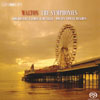Walton Symphonies Nos 1 & 2
An international approach to Walton that pays rich dividends
View record and artist detailsRecord and Artist Details
Composer or Director: William Walton
Genre:
Orchestral
Label: BIS
Magazine Review Date: 13/2010
Media Format: Hybrid SACD
Media Runtime: 0
Mastering:
Stereo
DDD
Catalogue Number: BIS-SACD1646

Tracks:
| Composition | Artist Credit |
|---|---|
| Symphony No. 1 |
William Walton, Composer
Lille National Orchestra Owain Arwel Hughes, Conductor William Walton, Composer |
| Symphony No. 2 |
William Walton, Composer
Lille National Orchestra Owain Arwel Hughes, Conductor William Walton, Composer |
Author: Edward Greenfield
In the 1930s when the First Symphony was written, Walton was regarded as adventurously modern, influenced by the example of Sibelius’s symphonies, but when he wrote the Second, between 1957 and 1960, his music was out of fashion in times when serialism was in the ascendant. Nowadays that change of fashion is of no importance, for what matters is having two such attractive, invigorating works. That especially applies to the First Symphony, an iconic work of its period. In the astringent first three movements, the long crescendos of naggingly repetitious ostinatos are firmly controlled by Hughes, while the emotional climax of the slow movement is cathartic in just the right way. The finale leads on naturally to the style of Walton’s film music, with Hughes controlling the build-up of the two big fugatos most effectively.
The Second Symphony inhabits a much less tortured world with many beauties, as for example in the very opening with its gentle percussion and use of piano. Here the jagged syncopations are not so much electrifying as simply vigorous, while the slow movement comes closest to the mood of the equivalent movement of the First Symphony. The finale brings a typical touch of Waltonian tongue-in-cheek humour: the theme for his passacaglia variations is a 12-note row, enunciated boldly in unison at the start and the conclusion.
These symphonies have been paired on CD before, on an EMI Eminence disc conducted by Sir Charles Mackerras, but this is no longer available. With magnetic performances and clear recorded sound, this is a disc to recommend warmly. I hope Hughes will now go on to record more Walton.
Discover the world's largest classical music catalogue with Presto Music.

Gramophone Digital Club
- Digital Edition
- Digital Archive
- Reviews Database
- Full website access
From £8.75 / month
Subscribe
Gramophone Full Club
- Print Edition
- Digital Edition
- Digital Archive
- Reviews Database
- Full website access
From £11.00 / month
Subscribe
If you are a library, university or other organisation that would be interested in an institutional subscription to Gramophone please click here for further information.




